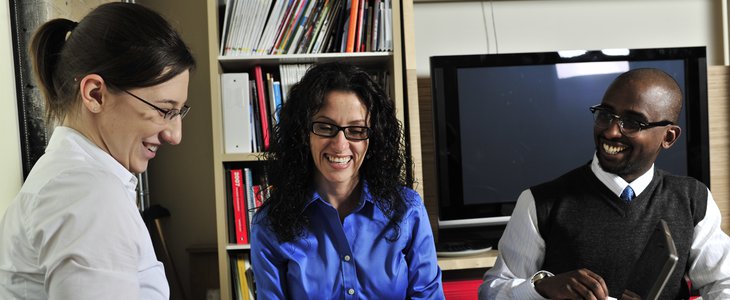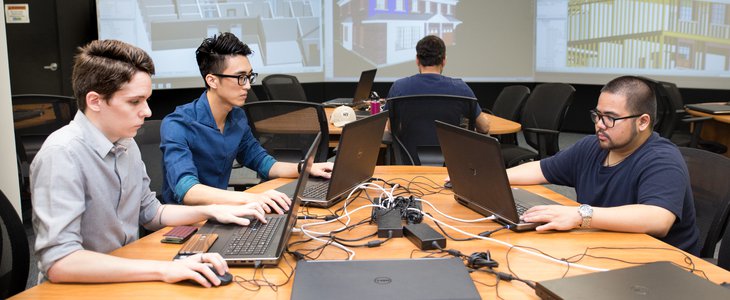1
Essential Employability Skills
Essential Employability Skills

True or False
There are many myths and misunderstandings about EES. What do you think?

EES Matter! Here’s Why
Individuals with higher levels of essential skills, learn better, earn more and are in better health.
Smarten Up Report, Canada West Foundation, 2015
The Government of Ontario mandates that all college graduates possess skills in the following six categories:
- Communication
- Numeracy
- Critical thinking and problem solving
- Information management
- Interpersonal
- Personal
These Essential Employability Skills (EES) are also called soft skills, people skills, and transferable skills. Whatever name you use, and regardless of a student’s program or discipline, these skills are critical for success in day-to-day living, and increasingly, in the workplace.
Employers expect college grads to have competent technical and knowledge skills, but they rate well-developed soft skills as the most important attribute in new hires. To stand out, grads must be able to communicate ideas, use numerical data, solve problems, organize and apply information, and be reliable, responsible team members.
Colleges are well-positioned to prepare learners for the workplace. The mandate of colleges is to “assist individuals in finding and keeping employment, meet the needs of employers and changing work environments and support the economic and social development of their local and diverse communities”. (Ontario Colleges of Applied Arts and Technology Act, 2002)
This guide will help you integrate EES into your courses to equip our students with these vital skills.
Most GTA employers agree that it is a graduate’s soft skills that set them apart, beyond the technical skills.
George Brown College Employer Tracking Study conducted by NorthStar Research Partners, 2015

3 Steps to Get Started
1. Take a program perspective
EES are skills that students develop throughout their experience in the whole program, and responsibility for teaching/learning, practicing and evaluating them is shared among courses. Knowing which of the EES learning outcomes fits best with your course will help your Chair to ensure the program covers all 11 EES outcomes.
2. Understand the terms
- T/L means the EES is taught and learned in the classroom (physical or virtual).
- P means that after they’ve been taught a skill, students have an opportunity to practice it, with formative feedback from you and/or their peers.
- E means that a grade or mark is connected to your assessment of the skill.
3. Complete your course outline
There are two sections on your course outline, EES and evaluation, where you accurately reflect which of the 11 EES learning outcomes will be taught/learned, practiced and/or evaluated in the course.
As a general guideline, aim to Teach/Learn (T/L), Practice (P) and Evaluate (E) two to three EES in a course. You can adapt this guideline if the course is:
- field-based
- considered a capstone
- designed specifically to address one or more categories of EES skills
- has extensive contact hours
In the evaluation table, remember to allocate a significant portion of the grade to evaluating the EES indicated. There’s no set rule on this BUT if you have assigned too many outcomes and EES to an evaluation tool, this significance diminishes.
Transferable skills such as teamwork and critical thinking often develop over multiple learning experiences, rather than within the boundaries of a single course.
Undergraduates’ Understanding of Skill-based Learning Outcomes: Can e-portfolios Help, HEQCO, 2014
Top Tips to Integrate EES
1. Think ‘multipurpose’
You can use the same activity to teach/learn, practice and evaluate an EES.
Example: Case study
- Teach your class to analyze a case study according to a particular framework. (T/L)
- Give the students a new case study to analyze in small groups, while you circulate to answer questions and give feedback. (P)
- As the final test, have the students analyze a case study on their own. (E)
2. Be strategic
Think about how each EES skill is demonstrated in your field.
Example: Ask yourself
- How are problems identified and solved?
- What types of teams are typical?
- How is information communicated?
3. Evaluate throughout
Make the most of your in-class time. If you are teaching and practicing a skill with students, you could be evaluating their work, too.
Evaluations can assess more than one EES at a time and/or one or more course outcomes at a time.
You can evaluate an EES at the introductory, intermediate or culminating level depending on the course context and where the course falls in the program schedule.
Example: You could assess EES #8 (Show respect for the diverse opinions, values, belief systems and contributions of others) at an:
- Introductory level - have students explain the concept of social sustainability
- Intermediate level- ask students to explain how social sustainability connects to their field
- Culminating level- use a self-reflection tool to assess how students incorporated social sustainability in a group project
Nearly 1/3 of 16 to 25 year-olds are short of some essential skills for their jobs.
Canada West Foundation, 2015
Your EES Workbook
It’s your turn! Here are some ways that GBC faculty teach/learn, practice and evaluate the 11 EES.
- Check the activities that interest you
- Scribble your own ideas

11 EES Learning Strategies to Try
EES 1: Cocktail Party
This works well when content can be illustrated through multiple examples. Students gather in ‘parties’ and share experiences and stories related to the topic or theme. They ‘mingle’ in order to listen to a variety of experiences.
EES 2: Learning Jigsaw
Break the content to be learned into ‘chunks’. In home groups, students number off. Then all the like numbers work together to understand their assigned ‘chunk.’ Students return to their home groups to present this portion of the content.
EES 3: Travelling File
Place a series of problems to be solved in file folders. Each student or group of students works on the problem for five minutes. Pass the file and have students correct and/or continue the previous group’s work. Pass the files until the problems are solved.
EES 4: Diagnostics
Present students with a problem or case study before introducing content that will help them solve it. After presenting the content, have students revisit the problem or case study to determine how they would approach it differently.
EES 5: Brainstorming & Mind Mapping
Present groups of students with a problem. Using principles of creative thinking, have students brainstorm as many solutions to the problem as possible (this could be timed.) Then have each student choose a solution from the mind map and present the reasoning behind their choice.
EES 6: Paper Sorter
Gather resources on a topic. Choose some that are credible, some questionable, some relevant, others irrelevant. Have small groups sort the resources to decide which they would use in a paper or project and which they would discard. Have students create a reference page for the useful pile.
EES 7: KWL
Pick a topic and have students list what they know about the topic and want to know about the topic. Have them locate primary and/or secondary resources that will answer what they want to know. Ask them to write what they’ve learned, with resource documentation.
EES 8: Storytelling Trio
Organize students into threes; have them tell a story on a common theme. Have one student tell the story. The second student reports back the content of the story. The third reports back on an assigned component of the story such as its values or impact. Rotate roles. As a group, have students compare/contrast their stories.
EES 9: Classroom Guidelines
Have students in small groups discuss the learning environment they want. After creating classroom guidelines, reflect periodically throughout the course on how these have been followed as a group, making changes as needed.
EES 10: Roadmap
Have students create a roadmap between point A (current time) and point B (when a major assignment is due) with stops along the way representing steps in the assignment. Visually represent the road, including possible detours, traffic jams etc., that represent different stressors on their time and have them propose solutions to these.
EES 11: Reflection Slip
When handing back a test or assignment, provide a slip of paper with two or three questions such as: What did I do well? What would I have done differently? What will I try next time? Have students hand in these slips in a box by the classroom door. Marks are assigned for completing these and the slip is handed back and modified after the next assessment.
NOTE: For more information on EES and how to integrate them in your courses, visit the Academic Excellence page on George Brown College’s intranet for a list of helpful sources and links.
Essential Employability Skills
| SKILL CATEGORY | LEARNING OUTCOMES: The levels of achievement required by graduates. The graduate has reliably demonstrated the ability to: | DEFINING SKILLS: Skill areas to be demonstrated by graduates: |
|---|---|---|
| COMMUNICATION |
Essential Employability Skill #1Communicate clearly, concisely and correctly in the written, spoken, and visual form that fulfills the purpose and meets the needs of the audience.
Essential Employability Skill #2Respond to written, spoken, or visual messages in a manner that ensures effective communication. |
|
| NUMERACY |
Essential Employability Skill #3Execute mathematical operations accurately. |
|
| CRITICAL THINKING & PROBLEM SOLVING |
Essential Employability Skill #4Apply a systematic approach to solve problems.
Essential Employability Skill #5Use a variety of thinking skills to anticipate and solve problems. |
|
| INFORMATION MANAGEMENT |
Essential Employability Skill #6Analyze, evaluate, and apply relevant information from a variety of sources.
Essential Employability Skill #7Locate, select, organize, and document information using appropriate technology and information systems. |
|
| INTERPERSONAL |
Essential Employability Skill #8Show respect for the diverse opinions, values, belief systems, and contributions of others.
Essential Employability Skill #9Interact with others in groups or teams in ways that contribute to effective working relationships and the achievement of goals. |
|
| PERSONAL |
Essential Employability Skill #10Manage the use of time and other resources to complete projects.
Essential Employability Skill #11Take responsibility for one’s own actions, decisions, and consequence. |
|